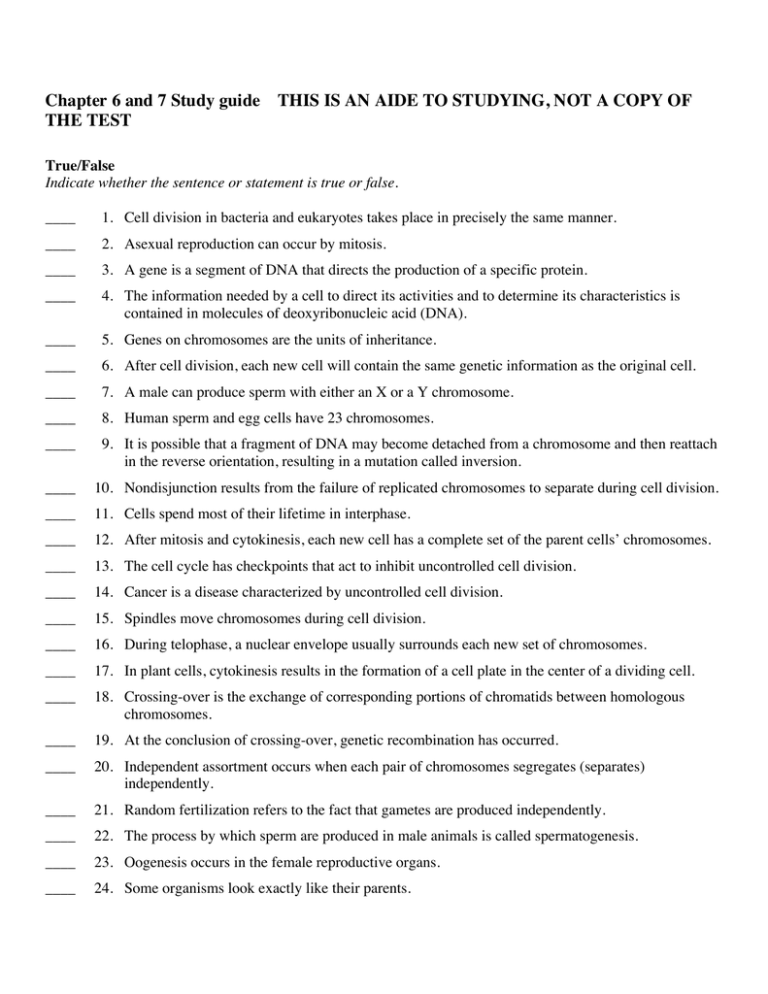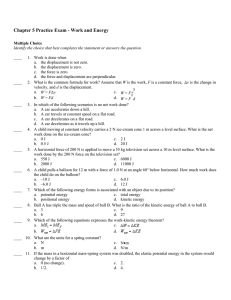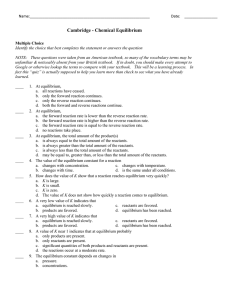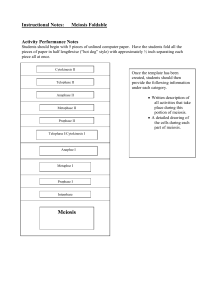Chapter 6 and 7 Study guide THIS IS AN AIDE TO STUDYING, NOT
Anuncio

Chapter 6 and 7 Study guide THE TEST THIS IS AN AIDE TO STUDYING, NOT A COPY OF True/False Indicate whether the sentence or statement is true or false. ____ 1. Cell division in bacteria and eukaryotes takes place in precisely the same manner. ____ 2. Asexual reproduction can occur by mitosis. ____ 3. A gene is a segment of DNA that directs the production of a specific protein. ____ 4. The information needed by a cell to direct its activities and to determine its characteristics is contained in molecules of deoxyribonucleic acid (DNA). ____ 5. Genes on chromosomes are the units of inheritance. ____ 6. After cell division, each new cell will contain the same genetic information as the original cell. ____ 7. A male can produce sperm with either an X or a Y chromosome. ____ 8. Human sperm and egg cells have 23 chromosomes. ____ 9. It is possible that a fragment of DNA may become detached from a chromosome and then reattach in the reverse orientation, resulting in a mutation called inversion. ____ 10. Nondisjunction results from the failure of replicated chromosomes to separate during cell division. ____ 11. Cells spend most of their lifetime in interphase. ____ 12. After mitosis and cytokinesis, each new cell has a complete set of the parent cells’ chromosomes. ____ 13. The cell cycle has checkpoints that act to inhibit uncontrolled cell division. ____ 14. Cancer is a disease characterized by uncontrolled cell division. ____ 15. Spindles move chromosomes during cell division. ____ 16. During telophase, a nuclear envelope usually surrounds each new set of chromosomes. ____ 17. In plant cells, cytokinesis results in the formation of a cell plate in the center of a dividing cell. ____ 18. Crossing-over is the exchange of corresponding portions of chromatids between homologous chromosomes. ____ 19. At the conclusion of crossing-over, genetic recombination has occurred. ____ 20. Independent assortment occurs when each pair of chromosomes segregates (separates) independently. ____ 21. Random fertilization refers to the fact that gametes are produced independently. ____ 22. The process by which sperm are produced in male animals is called spermatogenesis. ____ 23. Oogenesis occurs in the female reproductive organs. ____ 24. Some organisms look exactly like their parents. ____ 25. In asexual reproduction, two parents each pass copies of all of their cells to their offspring. ____ 26. In sexual reproduction, two parents each form haploid cells, which join to form offspring. ____ 27. Some eukaryotes reproduce asexually, and some reproduce sexually. ____ 28. Amoebas reproduce by fission. ____ 29. The pairing of homologous chromosomes during meiosis may have originally been a way to repair damaged DNA. ____ 30. Genetic diversity is the raw material for evolution. ____ 31. In most animals, including humans, meiosis produces sperm and egg cells. ____ 32. During the haploid life cycle, the zygote is the only diploid cell. ____ 33. Plants, algae, and some protists have a life cycle that regularly alternates between a haploid phase and a diploid phase. ____ 34. In the life cycle of a plant, the gametophyte is the haploid phase that produces gametes by mitosis. ____ 35. Unlike a gamete, a spore gives rise to a multicellular individual without joining with another cell. ____ 36. Roses are examples of plants that have a life cycle called alternation of generations. ____ 37. Moss plants have haploid life cycles. Multiple Choice Identify the letter of the choice that best completes the statement or answers the question. ____ ____ ____ ____ 38. Refer to the illustration above. The cell in diagram 1 is in a. metaphase. c. anaphase. b. telophase. d. prophase. 39. Refer to the illustration above. Mitosis begins with the stage shown in diagram a. 1. c. 3. b. 2. d. 4. 40. Refer to the illustration above. The cell shown in diagram 5 is in a. metaphase. c. anaphase. b. telophase. d. prophase. 41. Mitosis is a process by which a. DNA is replicated. c. cells grow in size. b. cytokinesis occurs. d. a cell’s nucleus divides. ____ 42. Refer to the illustration above. Which of the following correctly indicates the order in which these events occur? a. A, B, C, D c. B, A, C, D b. C, B, A, D d. A, C, B, D ____ 43. Refer to the illustration above. The process shown is a. mitosis. c. meiosis. b. chromosomal mutation. d. dominance. Using the information you have learned about cell reproduction, infer answers to the questions below about a cell with a diploid number of 4 chromosomes. Select from among the diagrams below, labeled A, B, C, D, and E, to answer the questions. ____ 44. Which of the diagrams above depicts a cell at the beginning of mitosis? a. B c. D b. C d. E ____ ____ ____ ____ 45. Which of the diagrams above depicts a cell at the end of meiosis I? a. B c. D b. C d. E 46. Which of the diagrams above depicts a cell at the end of meiosis 2? a. A c. C b. B d. D 47. Which of the diagrams above depicts a cell at the end of mitosis? a. A c. C b. B d. D 48. Crossing-over occurs a. during prophase 2. c. during prophase I. b. during fertilization. d. at the centromere. Completion Complete each sentence or statement. 49. Binary ____________________ is the process by which bacteria split asexually into two identical organisms. 50. In bacteria, cell division takes place in two stages. First the ____________________ is copied, and then the cell splits. 51. Growth occurs through cell enlargement and cell ____________________. 52. Following replication of its DNA, each chromosome contains two ____________________, which are attached to each other by a centromere. 53. The DNA in eukaryotic cells is packaged into structures that are called ____________________. 54. A(n) ____________________ is a segment of a DNA molecule that carries the instructions for producing a specific trait. 55. Chromosomes that are not involved in sex determination are called ____________________. 56. The X and Y chromosomes are called the ____________________ chromosomes. 57. In humans, the genotype XX results in a(n) ____________________. 58. A fertilized egg cell is called a(n) ____________________. 59. The diploid number of chromosomes is re-established through ____________________. 60. Fertilization of the haploid sperm and egg results in the restoration of the ____________________ number of chromosomes in the zygote. 61. Somatic cells containing two sets of 23 chromosomes are always ____________________. 62. The failure of replicated chromosomes to separate is called ____________________. 63. A mutation in which a piece of a chromosome is lost during meiosis is called a(n) ____________________. 64. In humans, the specific condition caused by an extra chromosome 21 is called ____________________ ____________________. 65. A picture of a cell’s chromosomes is called a(n) ____________________. 66. When a piece of chromosome attaches itself to a nonhomologous chromosome, the resulting mutation is called a(n) ____________________. 67. The sequence of events that occurs in a cell from one mitotic division to the next is called the ____________________ ____________________. 68. Collectively, the time spent in G1 + S + G2 is called ____________________. 69. A cell’s DNA is copied during the ____________________ phase. 70. Cells that are not dividing remain in the ____________________ phase. 71. Normal cell growth and cell division are stimulated by ____________________. 72. The ____________________ checkpoint triggers the exit from mitosis. 73. The cell cycle is controlled in eukaryotes at three principal ____________________. 74. DNA replication is checked at the ____________________ checkpoint. 75. Loss of control and regulation of the ____________________ ____________________ can result in the development of cancer. 76. Cancer is a disease of ____________________ ____________________. 77. “Cables” made of microtubules that extend from the poles of a cell to the centromeres during cell division are called ____________________ ____________________. 78. Spindle fibers are made of hollow tubes of protein called ____________________. 79. In mitosis, anaphase follows ____________________. 80. Chromosomes coil up into short, fat rods during ____________________. 81. Chromosomes coil up and become visible during ____________________. 82. Chromatids migrate toward poles as spindle fibers shorten during ____________________. 83. In many eukaryotic cells, ____________________ takes place after the nucleus divides. 84. After a new nuclear membrane forms during telophase of mitosis or meiosis, the ____________________ divides, resulting in two cells. 85. In plant cells, a(n) ____________________ ____________________ forms in the center of the cell during cytokinesis. 86. The stage of meiosis during which homologues line up along the equator of the cell is called ____________________ ____________________. 87. Fertilization of the haploid sperm and egg results in the restoration of the ____________________ number of chromosomes in the zygote. 88. After a new nuclear membrane forms during telophase of meiosis, the ____________________ divides, resulting in two cells. 89. The cells resulting from meiosis in either males or females are called ____________________. 90. The process called ____________________ guarantees that the number of chromosomes in gametes is half the number of chromosomes in body cells. 91. A reciprocal exchange of corresponding segments of DNA is called ________________________________________. 92. The four haploid cells formed in the male at the end of meiosis 2 develop a tail and are called ____________________. 93. An individual produced by asexual reproduction that is genetically identical to its parent is called a(n) ____________________. 94. The separation of a parent into two or more individuals of about equal size is called ____________________. 95. The process in which sperm and egg cells join is called ____________________. 96. A spore is a haploid reproductive cell produced by ____________________. 97. The entire span in the life of an organism from one generation to the next is called a(n) ____________________ ____________________. 98. The diploid phase in the life cycle of plants is called the ____________________. Essay 99. Refer to the illustration above. Identify the structure in the drawing and discuss its importance during eukaryotic cell division. 100. What would happen if the chromosome number were not reduced before sexual reproduction? Chapter 6 and 7 Study guide THE TEST Answer Section THIS IS AN AIDE TO STUDYING, NOT A COPY OF TRUE/FALSE 1. 2. 3. 4. 5. 6. 7. 8. 9. 10. 11. 12. 13. 14. 15. 16. 17. 18. 19. 20. 21. 22. 23. 24. 25. 26. 27. 28. 29. 30. 31. 32. 33. 34. 35. 36. ANS: ANS: ANS: ANS: ANS: ANS: ANS: ANS: ANS: ANS: ANS: ANS: ANS: ANS: ANS: ANS: ANS: ANS: ANS: ANS: ANS: ANS: ANS: ANS: ANS: ANS: ANS: ANS: ANS: ANS: ANS: ANS: ANS: ANS: ANS: ANS: F T T T T T T T T T T T T T T T T T T T F T T T F T T T T T T T T T T T DIF: DIF: DIF: DIF: DIF: DIF: DIF: DIF: DIF: DIF: DIF: DIF: DIF: DIF: DIF: DIF: DIF: DIF: DIF: DIF: DIF: DIF: DIF: DIF: DIF: DIF: DIF: DIF: DIF: DIF: DIF: DIF: DIF: DIF: DIF: DIF: I I I I I I I I I I I I I I I I I I I I I I I I I I I I I I I I I I I I OBJ: OBJ: OBJ: OBJ: OBJ: OBJ: OBJ: OBJ: OBJ: OBJ: OBJ: OBJ: OBJ: OBJ: OBJ: OBJ: OBJ: OBJ: OBJ: OBJ: OBJ: OBJ: OBJ: OBJ: OBJ: OBJ: OBJ: OBJ: OBJ: OBJ: OBJ: OBJ: OBJ: OBJ: OBJ: OBJ: 6.1.1 6.1.1 6.1.2 6.1.2 6.1.2 6.1.2 6.1.3 6.1.4 6.1.5 6.1.5 6.2.1 6.2.1 6.2.2 6.2.3 6.3.1 6.3.2 6.3.3 7.1.2 7.1.2 7.1.2 7.1.2 7.1.3 7.1.3 7.2.1 7.2.1 7.2.1 7.2.1 7.2.2 7.2.3 7.2.3 7.2.4 7.2.4 7.2.4 7.2.4 7.2.4 7.2.4 STO: STO: STO: STO: STO: STO: STO: STO: STO: STO: STO: STO: STO: STO: STO: STO: STO: STO: STO: STO: STO: STO: STO: STO: STO: STO: STO: STO: STO: STO: STO: STO: STO: STO: STO: STO: BIO.5a BIO.5a BIO.4a BIO.6f BIO.6f BIO.6a BIO.6b BIO.6b BIO.6e BIO.6e BIO.6a BIO.6a BIO.6a BIO.6a BIO.6a BIO.6a BIO.6a BIO.6b BIO.6b BIO.6b BIO.6b BIO.6b BIO.6b BIO.6b BIO.6b BIO.6b BIO.6b BIO.6b BIO.6b BIO.2b BIO.6b BIO.6b BIO.5a BIO.5a BIO.5a BIO.5a 37. ANS: F DIF: I OBJ: 7.2.4 STO: BIO.5a DIF: DIF: DIF: DIF: DIF: DIF: DIF: DIF: DIF: DIF: DIF: II II I I II II II III II II I OBJ: OBJ: OBJ: OBJ: OBJ: OBJ: OBJ: OBJ: OBJ: OBJ: OBJ: STO: STO: STO: STO: STO: STO: STO: STO: STO: STO: STO: MULTIPLE CHOICE 38. 39. 40. 41. 42. 43. 44. 45. 46. 47. 48. ANS: ANS: ANS: ANS: ANS: ANS: ANS: ANS: ANS: ANS: ANS: C B B D B C C D A B C 6.3.2 6.3.2 6.3.2 6.3.2 6.3.2 7.1.1 7.1.1 7.1.1 7.1.1 7.1.1 7.1.2 COMPLETION 49. ANS: fission DIF: I 50. ANS: DNA OBJ: 6.1.1 STO: BIO.6a DIF: I 51. ANS: division OBJ: 6.1.1 STO: BIO.5a DIF: I 52. ANS: chromatids OBJ: 6.1.1 STO: BIO.6a DIF: I OBJ: 6.1.2 53. ANS: chromosomes STO: BIO.6a DIF: I 54. ANS: gene OBJ: 6.1.2 STO: BIO.6f DIF: I 55. ANS: autosomes OBJ: 6.1.2 STO: BIO.6f DIF: I 56. ANS: sex OBJ: 6.1.3 STO: BIO.6f DIF: I 57. ANS: female OBJ: 6.1.3 STO: BIO.6f BIO.6a BIO.6a BIO.6a BIO.6a BIO.6a BIO.6b BIO.6a BIO.6b BIO.6b BIO.6a BIO.6b DIF: I 58. ANS: zygote OBJ: 6.1.3 STO: BIO.6c DIF: II 59. ANS: fertilization OBJ: 6.1.4 STO: BIO.6c DIF: II 60. ANS: diploid OBJ: 6.1.4 STO: BIO.6c DIF: II 61. ANS: diploid OBJ: 6.1.4 STO: BIO.6c DIF: II OBJ: 6.1.4 62. ANS: nondisjunction STO: BIO.6c DIF: II 63. ANS: deletion OBJ: 6.1.4 STO: BIO.6e DIF: I OBJ: 6.1.5 64. ANS: Down syndrome STO: BIO.6e DIF: I 65. ANS: karyotype OBJ: 6.1.5 STO: BIO.6e DIF: I OBJ: 6.1.5 66. ANS: translocation STO: BIO.6h DIF: II 67. ANS: cell cycle OBJ: 6.1.5 STO: BIO.6e DIF: I 68. ANS: interphase OBJ: 6.2.1 STO: BIO.6a DIF: I 69. ANS: synthesis OBJ: 6.2.1 STO: BIO.6a DIF: I 70. ANS: G1 first growth OBJ: 6.2.1 STO: BIO.6a DIF: I 71. ANS: proteins OBJ: 6.2.1 STO: BIO.6a OBJ: 6.2.2 STO: BIO.6a DIF: I 72. ANS: mitosis DIF: I 73. ANS: checkpoints OBJ: 6.2.2 STO: BIO.6a DIF: I 74. ANS: S synthesis OBJ: 6.2.2 STO: BIO.6a DIF: I 75. ANS: cell cycle OBJ: 6.2.2 STO: BIO.6a DIF: II OBJ: 6.2.3 76. ANS: cell division STO: BIO.6a DIF: II OBJ: 6.2.3 77. ANS: spindle fibers STO: BIO.6a DIF: I OBJ: 6.3.1 78. ANS: microtubules STO: BIO.6a DIF: I 79. ANS: metaphase OBJ: 6.3.1 STO: BIO.6a DIF: I 80. ANS: prophase OBJ: 6.3.2 STO: BIO.6a DIF: I 81. ANS: prophase OBJ: 6.3.2 STO: BIO.6a DIF: I 82. ANS: anaphase OBJ: 6.3.2 STO: BIO.6a DIF: I 83. ANS: cytokinesis OBJ: 6.3.2 STO: BIO.6a DIF: I 84. ANS: cytoplasm OBJ: 6.3.3 STO: BIO.6a DIF: I 85. ANS: cell plate OBJ: 6.3.3 STO: BIO.6a DIF: II 86. ANS: metaphase I OBJ: 6.3.3 STO: BIO.6a DIF: II 87. ANS: diploid OBJ: 7.1.1 STO: BIO.6b DIF: II 88. ANS: cytoplasm OBJ: 7.1.1 STO: BIO.6b DIF: II 89. ANS: gametes OBJ: 7.1.1 STO: BIO.6b DIF: II 90. ANS: meiosis OBJ: 7.1.1 STO: BIO.6b DIF: II OBJ: 7.1.1 91. ANS: crossing-over STO: BIO.6b DIF: II 92. ANS: sperm OBJ: 7.1.1 STO: BIO.6b DIF: II 93. ANS: clone OBJ: 7.1.3 STO: BIO.6b DIF: II 94. ANS: fission OBJ: 7.2.1 STO: BIO.6a DIF: II 95. ANS: fertilization OBJ: 7.2.2 STO: BIO.6a DIF: II 96. ANS: meiosis OBJ: 7.2.4 STO: BIO.6c DIF: II 97. ANS: life cycle OBJ: 7.2.4 STO: BIO.6c DIF: II 98. ANS: sporophyte OBJ: 7.2.4 STO: BIO.5a OBJ: 7.2.4 STO: BIO.5a DIF: ESSAY 99. ANS: II This is a chromosome, the structure where the DNA in eukaryotic cells is found. The chromosome is formed right before a eukaryotic cell divides. Chromosomes are made of two chromatids attached at the centromere. During mitosis, the nucleus of a cell divides into two nuclei, each containing a complete set of the cell’s chromosomes. Thus, each new cell formed during cell division contains identical DNA. DIF: III OBJ: 6.1.2 STO: BIO.6a 100. ANS: The number of chromosomes in the offspring would be double the number in the parents. The number and characteristics of chromosomes in cells determine the traits of the organism. The organism would almost certainly not survive the doubling of its chromosomes, and even if it did survive and reproduce, then the number of chromosomes would become unmanageably large after only a few generations. DIF: III OBJ: 7.1.1 STO: BIO.6b


